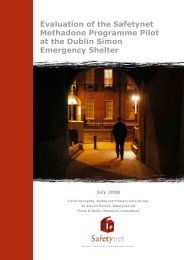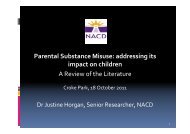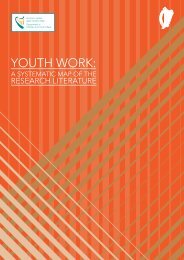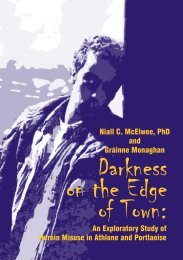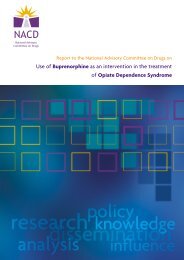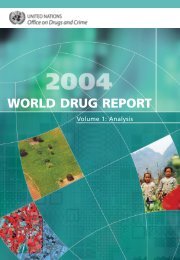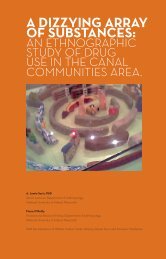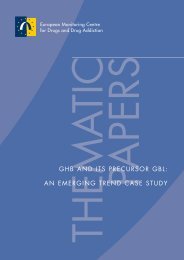Crack cocaine in the Dublin region - Health Research Board
Crack cocaine in the Dublin region - Health Research Board
Crack cocaine in the Dublin region - Health Research Board
Create successful ePaper yourself
Turn your PDF publications into a flip-book with our unique Google optimized e-Paper software.
5.2 <strong>Crack</strong> and o<strong>the</strong>r drugsMany of <strong>the</strong> <strong>in</strong>ternational f<strong>in</strong>d<strong>in</strong>gs discussed above emphasise that <strong>the</strong> majority ofcrack users have a history of problematic drug use (<strong>in</strong>volv<strong>in</strong>g opiates <strong>in</strong> particular). Thef<strong>in</strong>d<strong>in</strong>gs were borne out by this study. The NDTRS data show that <strong>in</strong>dividual cases mayreport us<strong>in</strong>g up to four problem drugs compris<strong>in</strong>g one ma<strong>in</strong> problem drug and up tothree additional problem drugs. As reported <strong>in</strong> Section 2.4, <strong>the</strong>re were 135 cases thatlived <strong>in</strong> Dubl<strong>in</strong> and reported crack <strong>coca<strong>in</strong>e</strong> as a problem drug between 2004 and 2006.Of <strong>the</strong>se 135 cases, 35 (26%) were be<strong>in</strong>g treated for <strong>the</strong> first time (Table 5.1).Table 5.1Number of cases who lived <strong>in</strong> Dubl<strong>in</strong> and were treated for problem crack <strong>coca<strong>in</strong>e</strong>use, by treatment status, as reported to <strong>the</strong> NDTRS, 2004 to 2006Year treatedTreatment status 2004 2005 2006 TotalNew cases 9 12 14 35Previously treated cases 34 26 34 94Treatment status unknown 2 0 4 6Total 45 38 52 135Eighteen cases reported crack <strong>coca<strong>in</strong>e</strong> as <strong>the</strong>ir ma<strong>in</strong> problem substance. Of <strong>the</strong>se, n<strong>in</strong>ehad been treated previously, and eight were enter<strong>in</strong>g treatment for <strong>the</strong> first time (Table5.2). Fourteen (78%) used more than one drug (Table 5.2 and Figure 5.1). The morecommon additional drugs were opiates or <strong>coca<strong>in</strong>e</strong> powder.Table 5.2Number of cases who lived <strong>in</strong> Dubl<strong>in</strong> and were treated for crack <strong>coca<strong>in</strong>e</strong> as a ma<strong>in</strong>problem drug, by treatment status, as reported to <strong>the</strong> NDTRS, 2004 to 2006Year treated<strong>Crack</strong> <strong>coca<strong>in</strong>e</strong> ma<strong>in</strong> problem drug by treatment status 2004 2005 2006 TotalNew cases 1 2 5 8Previously treated cases 3 2 4 9Treatment status unknown 0 0 1 1Total 4 4 10 18There were 117 cases who lived <strong>in</strong> Dubl<strong>in</strong> and were treated for problem crack <strong>coca<strong>in</strong>e</strong>use as an additional problem drug between 2004 and 2006. Of <strong>the</strong>se cases, 85 (73%)had been previously treated for problem drug use and only 27 (23%) were enter<strong>in</strong>gtreatment for <strong>the</strong> first time (Table 5.3).<strong>Crack</strong> <strong>coca<strong>in</strong>e</strong> <strong>in</strong> <strong>the</strong> Dubl<strong>in</strong> <strong>region</strong>: an evidence base for a crack <strong>coca<strong>in</strong>e</strong> strategy59




